On Being An Artist – At Any Age, At Any Time by Rachael McCampbell
Enjoy Rachael’s published article in the 101st issue of “Number, Inc” magazine. This article, “Being an Artist at Any Age, At Any Time,” was written to encourage anyone who has the spark or inclination to try art. And no matter what your age, be an artist for fun or for profit. There is no age limit on this profession. Begin now and enjoy all that comes with being an artist!
“I am passionate about teaching art. I try to encourage everyone I come across to paint. I find so much joy and peace in making art and I feel strongly that others will to if they’d give it a chance.”
Enjoy this article and share it with anyone you might know who would like to explore their creativity.
On Being An Artist – At Any Age, At Any Time
by Rachael McCampbell
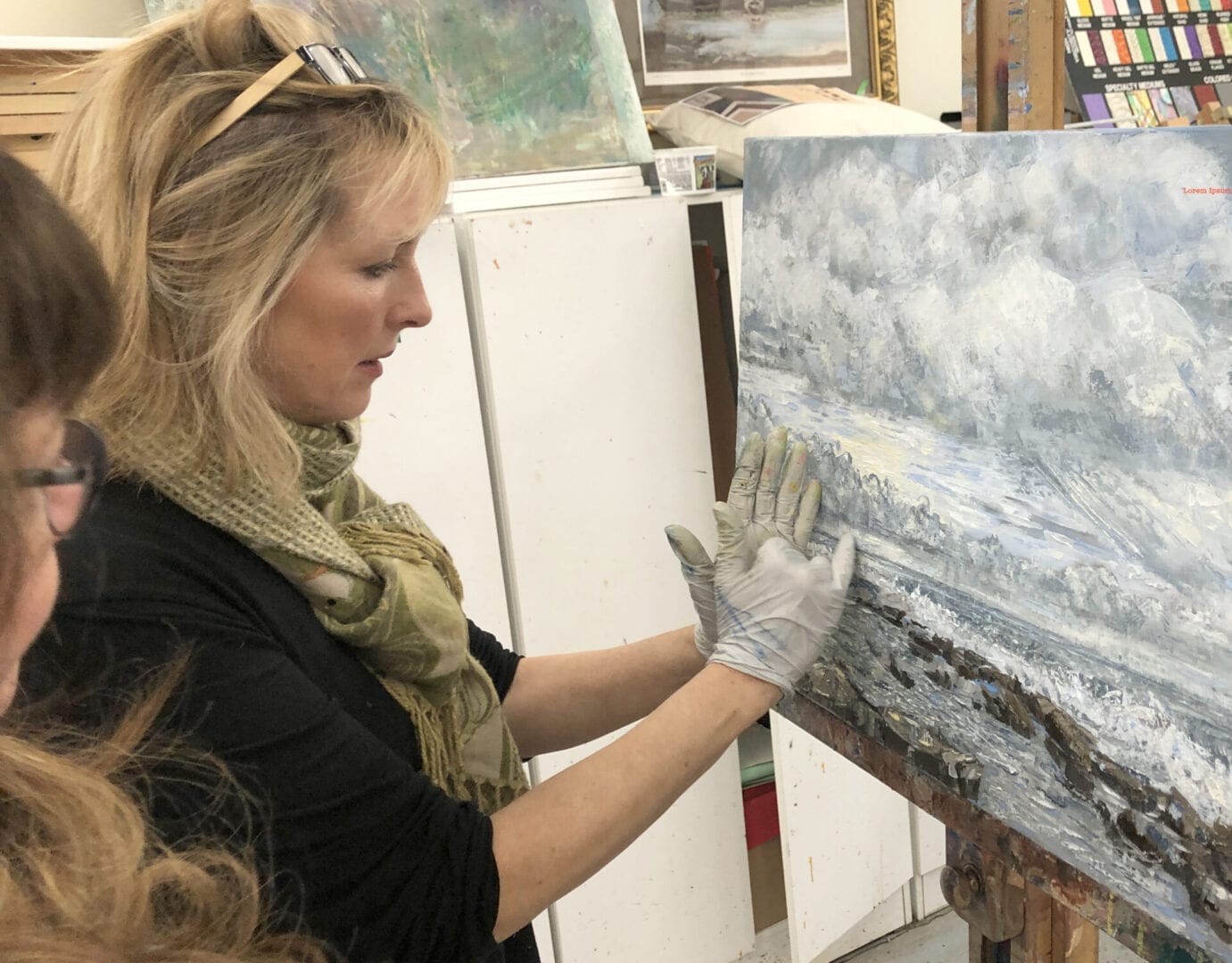
Rachael McCampbell teaching landscape class, 2020. Photo courtesy of Curtis Stewart.
There’s a romantic idea about being an artist. You may envision a French garret stuffed with canvases and a painter dreamily waiting for their muse to provide inspiration. Or a café crowded with artists drinking the night away excitedly discussing philosophical matters. Or perhaps a chic New York City art gallery filled with clients clamoring to pay in the high six-figures for an artist’s work. For some, I imagine these stories exist, but for most it’s about going to bed at a decent hour to rise the next morning and slog away in a converted space (inspired or not), followed by marketing on the computer in hopes of selling work that will pay the mortgage. I fall into the less romantic category, and I’m here to share some thoughts about becoming a fine artist with anyone considering this deeply gratifying but not always easy field. I encourage you to share this article with anyone who might have an interest in making art—no matter their age or experience level.
Since earning my BFA from the University of Georgia, I have worked in various art-related positions in New York City, London, Florence, Italy, Los Angeles and Nashville. These jobs include fabric and fashion designer, graphic designer, art gallery director, advertising photographer, commercial illustrator, landscape designer, interior color consultant, fine art painter, sculptor, art teacher, leader of art trips abroad and writer. Because of my array of experiences in the art field, I feel comfortable stating that there are many different ways to express yourself as an artist and get compensated too—and many more positions that I have not experienced. Some are highly lucrative salaried jobs (art director, website developer, animator, art professor, etc.) while others are riskier freelance opportunities, such as photographer, illustrator, or what I will discuss here—fine artist.

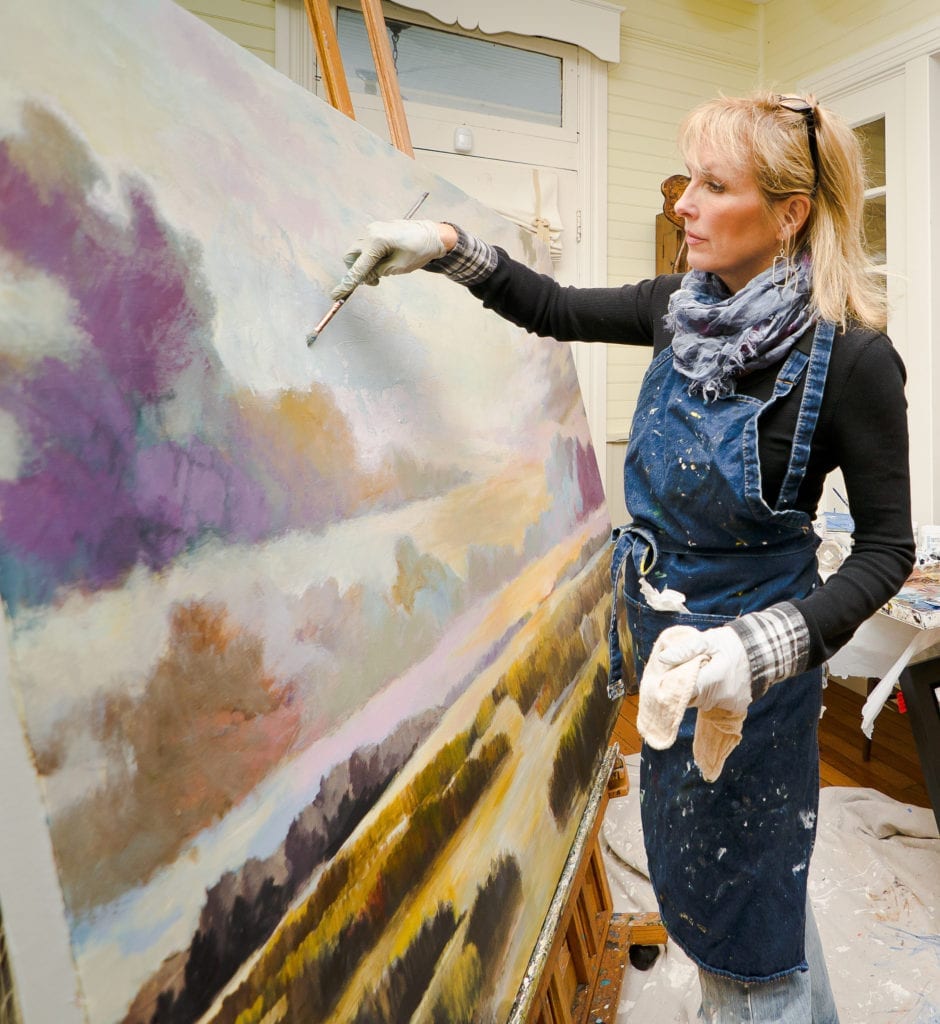 Rachael McCampbell panting, 2018. Photo courtesy of James Jordan Photography.
Rachael McCampbell panting, 2018. Photo courtesy of James Jordan Photography.
I am a tremendous believer in attending art school to learn from experienced educators, but if you cannot afford the time or tuition, don’t worry; there are other avenues. Literally thousands of people without formal art degrees (who are self-taught or take local, non-matriculating online classes) are augmenting their income or supporting themselves with their passion for art. With professional art teachers selling instructional videos online and artists sharing what they know on YouTube, a person can learn a great deal about art and make their first creations right in their own living room.
Outsider or intuitive art (artwork beyond the realm of the mainstream art world) mixed with an entrepreneurial spirit can be a powerful combination! You can see numerous examples of this on the Internet, and there’s even a museum for this genre in Chicago, Intuit: The Center for Intuitive or Outsider Art. With the advent of YouTube and social media platforms, art fairs, pop-up shows, etc., there are thousands of artists circumventing brick-and-mortar galleries and selling work on their own.
Being a self-taught artist is arguably one of the better ways to learn your craft. There is a great deal to recommend a trial-by-error method of education, especially for kinesthetic learners. By studying alone, an artist can avoid becoming unduly influenced by art trends that academia sometimes promotes. The downside is that, without the fellowship of learning from seasoned educators and other artists who share their knowledge and struggles, studying art alone can be a solitary and quite challenging experience. If you cannot attend an art school, I suggest that you find camaraderie and support in local art classes, community organizations[1], online forums and art support groups, such as, Facebook Groups and WetCanvas. There are often ways to audit courses at local universities or apply for art scholarships. Many private teachers, like myself, often offer a spot for a scholarship student who cannot afford the class—just inquire.

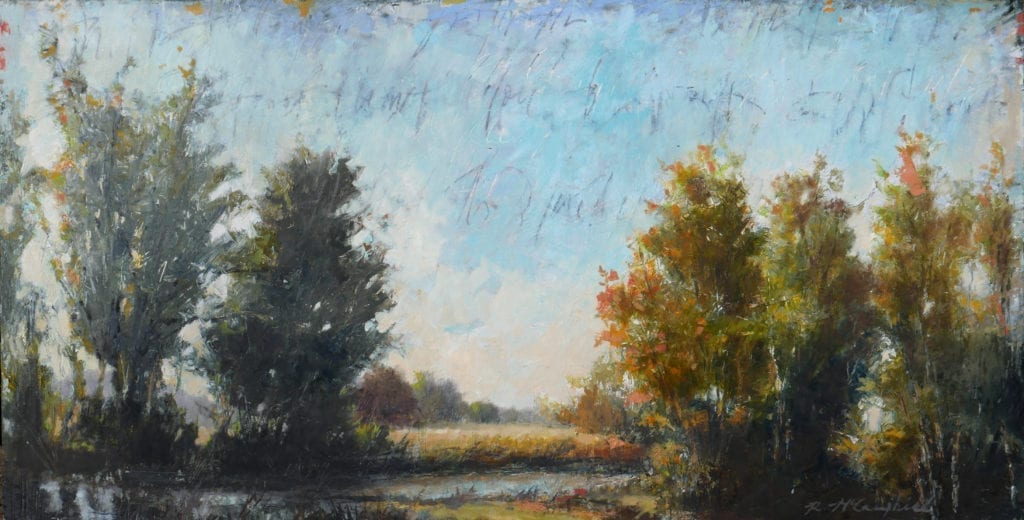 Rachael McCampbell, “Asemic Landscape”, 2020, oil and cold max medium on panel, 48″x24″. Photo courtesy of the author.
Rachael McCampbell, “Asemic Landscape”, 2020, oil and cold max medium on panel, 48″x24″. Photo courtesy of the author.However you choose to study art, it’s paramount that you educate yourself on how to use art materials properly. With today’s emphasis on conceptual art, multi-media and other non-traditional fine art degrees, I’ve noticed there is a gap in some art schools’ curricula on the correct use of art materials and the importance of being archival, no matter what type of art you are creating. This may sound pedantic, but being an art teacher, I cannot emphasize enough the importance of learning how to use your tools safely and in an archival fashion.
I recently saw someone state online that it was okay to paint acrylic gesso on top of an old oil painting and begin a new painting in acrylic on top of it—not an archival practice! If you cannot attend art school with access to valid information, I suggest turning to reputable websites such as the companies who make art materials—they are great resources[2]. You may think, My art isn’t selling now anyway—why should I care if it’s archival? Don’t be shortsighted. You may become an art star. Don’t be the artist that an art restorer (years from now) will curse for using cheap materials that were used wrongly. You want your work to last far beyond your lifetime.
Safety is important too. Many art materials can be toxic and dangerous to use. One of the greatest risks of YouTube classrooms is that inexperienced artists create many of the videos. They often have great ideas but don’t understand the tools they are using. I’ve seen artists sprinkle toxic pigments (high above their art) without using masks. I’ve watched them use blowtorches next to flammable liquids and heat encaustic wax in closed spaces with no respiratory masks or ventilation. Please educate yourself on the safest use of your materials.

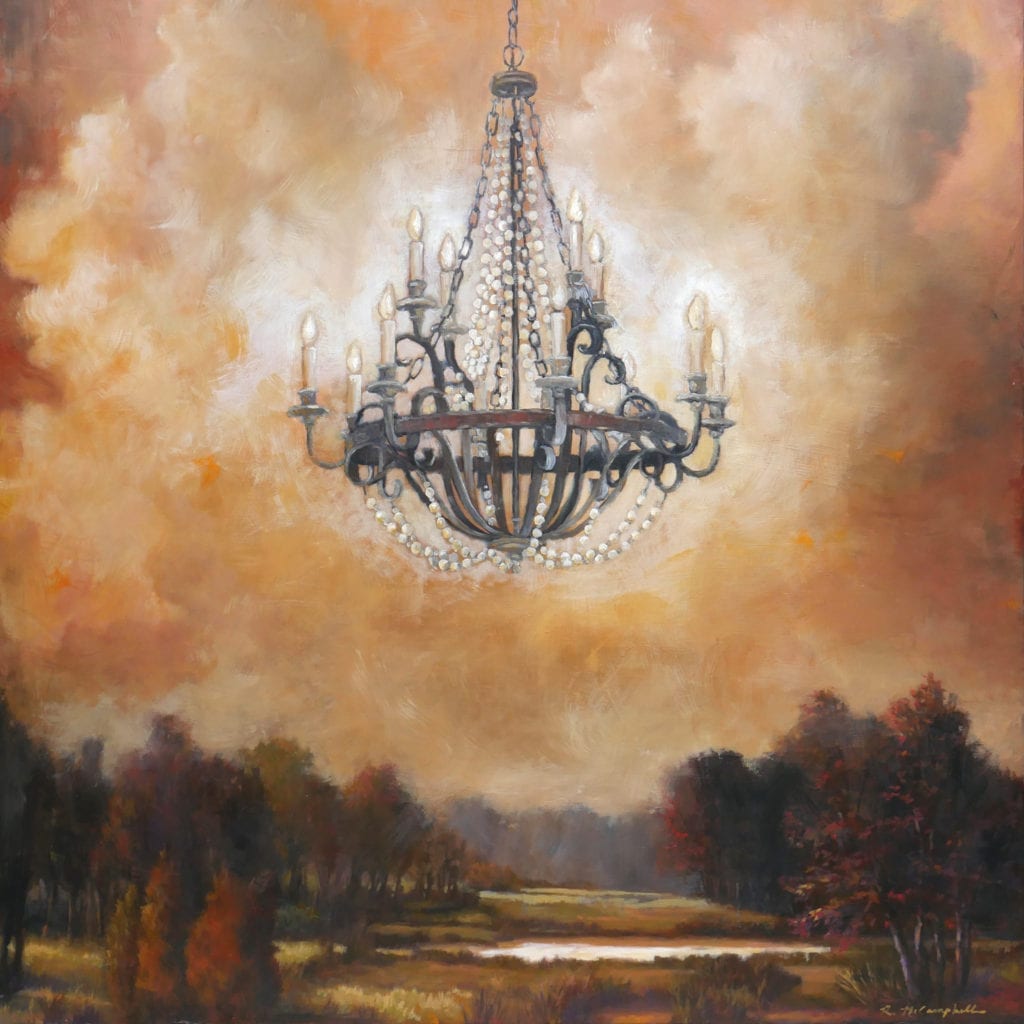 Rachael McCampbell, “Clouds That Whisper Your Name”, 2019, oil on panel, 36″x36″. Photo courtesy of the author.
Rachael McCampbell, “Clouds That Whisper Your Name”, 2019, oil on panel, 36″x36″. Photo courtesy of the author.
Once you feel confident about how to use your materials correctly and in an archival fashion, you are on your way. Learn the principles of art and elements of design. Understand how to create strong compositions, consider the rule of thirds and odds, study color theory and color mixing, then move deeper into your content. What is it you want to say with your art? What mood do you want to evoke? Do you want to express beauty through a painted seascape or make an environmental statement by creating a sculpture from litter found in that same seascape? There are no wrong answers—you are the creator here.
Leon Trotsky said, Art is not a mirror to hold up to society, but a hammer with which to shape it. His words ring truer now than ever. Art is far beyond the traditional norm of 2-D canvases or 3-D sculptures placed in a 19th century French salon. Artists are using their creativity to promote social change and awareness on many fronts. With the advent of digital art, multi-media and conceptual art in the 20th century, art has become inextricably tied to social change. It’s easy to imagine how to make money with paintings and sculptures, but how does an artist earn money in less traditional genres?
Conceptual artists, for example, can get compensated through grants, fellowships, sponsorships, paid residencies, or, like an ephemeral artist, they can sell the documentation of their work (think Andy Goldsworthy). Some conceptual artists keep a day job so they can make their art without worrying about sales for fear the monetization of their art might interfere with the integrity of their work.
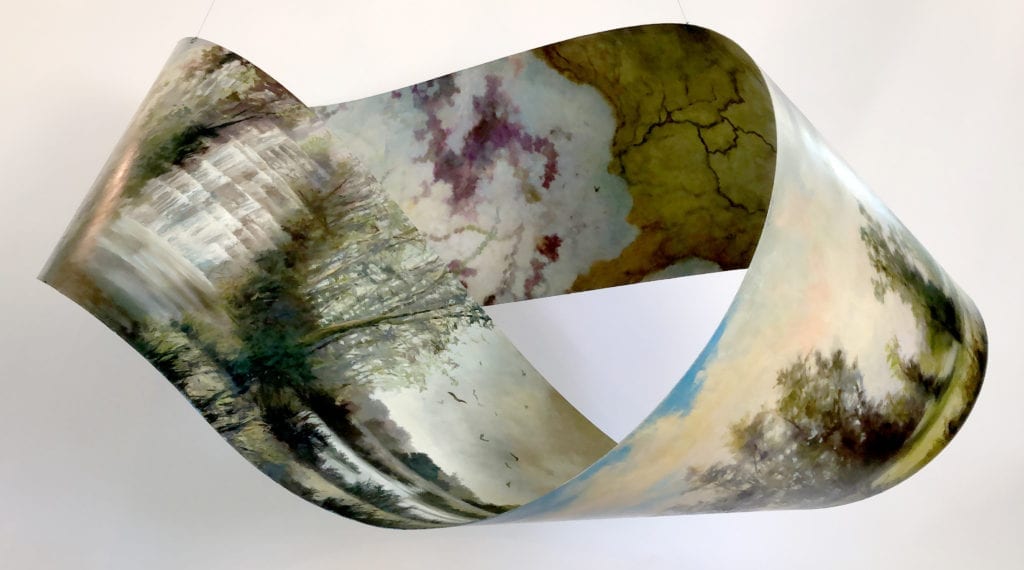
Rachael McCampbell, “Flowings”, 2019, oil on galvanized steel, 3D Mobius strip suspended from ceiling. Photo courtesy of the author.
No matter what genre you choose to work in, there are many steps to becoming a professional artist. This could range from getting your business cards printed to creating a consistent body of work, from writing an artist’s statement to the framing and presentation of your work, from building your website and social media platforms to writing grants and entering shows, from writing contracts for commissions to working with public art committees, from bookkeeping and paying sales tax to crating, shipping and installation. Like anything involving sales, it’s a business. There’s much more to this career than painting all day to your favorite music—much, much more. But even if you’re starting late in life, don’t be put off by this. It’s easy to learn and you can catch up quickly if you are devoted to the process.
I’ve met a great number of people who wanted to be artists but were told it wasn’t a practical way to make money, so they followed another career path. These people are now looking toward retirement and want to circle back to their first love—ART. They fear that it’s too late to begin or to make money as an artist. I’m here to tell you it is never too late. Just think of Grandma Moses who had her first show at seventy-eight years old, followed shortly afterwards with an exhibit at the MOMA in New York City. Some of my students are beginning to paint and sell their work in their sixties. Please don’t limit yourself by ageism or negative thinking.
Once you’ve figured out your voice and style, medium of choice and subject matter, begin creating work that moves you without consideration of what is trending or perceived important in the art world. If you make art because it means something to you, then I guarantee you that your art will resonate with someone else as well—someone who may actually purchase it! You may want to make art for personal satisfaction and give it away or you may want to have your work in fifteen galleries and five museums. Whatever your goal is, I suggest that you follow your heart, be professional, kind, fearless, always archival and most importantly, be yourself, no apologies!
Rachael McCampbell is a painter, sculptor, art teacher, writer, leader of painting trips in the US and Abroad, and most importantly she wants to spread the joy of painting and encourage others to enrich their lives through making art.
[1] State art commissions with links to local programs, classes, grants can be found in Tennessee (tnartscommission.org), Arkansas (arkansasarts.org), Alabama (arts.state.al.us) and Mississippi (arts.ms.gov).
[2] See Gamblin at gamblincolors.com and Golden at goldenpaints.com
